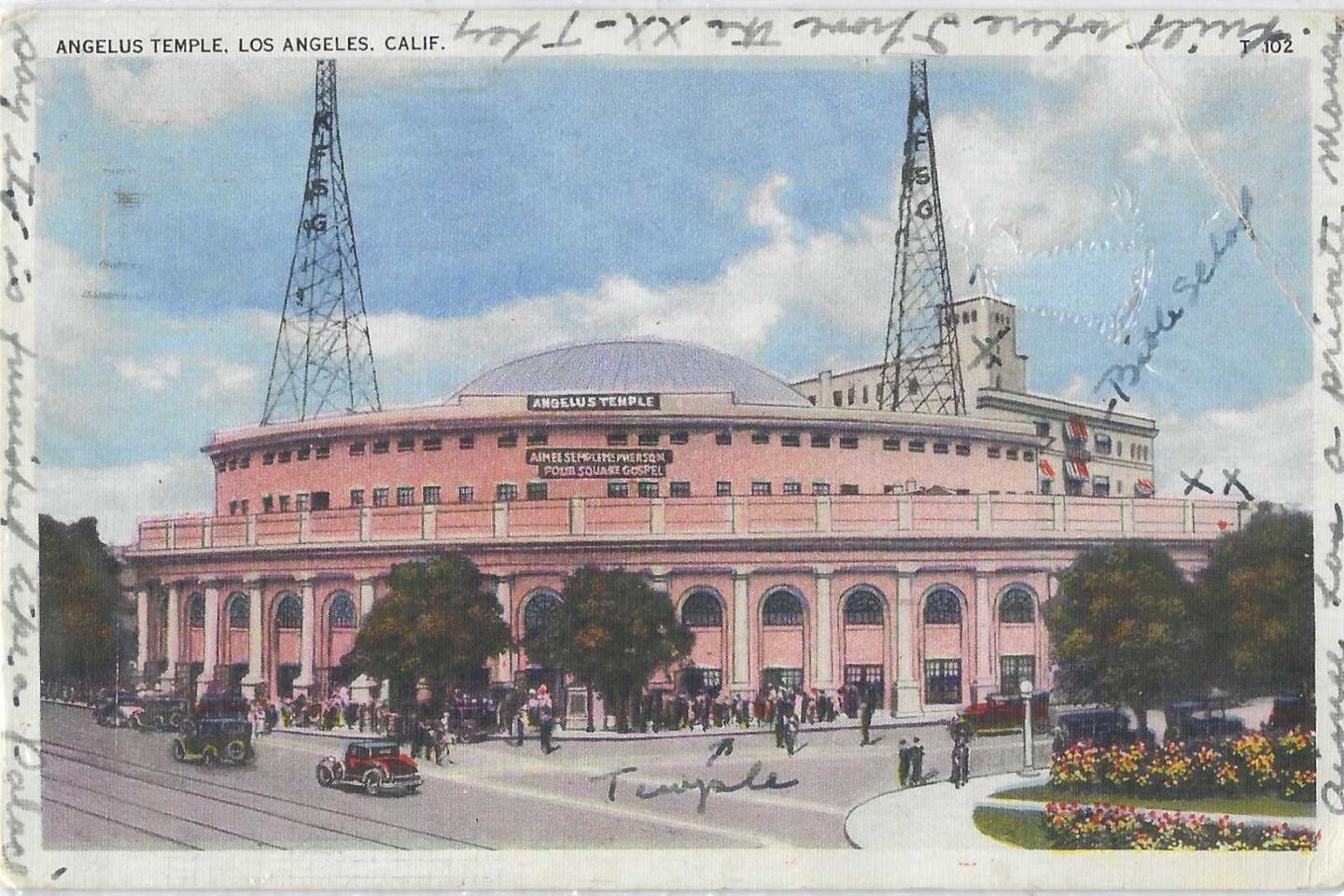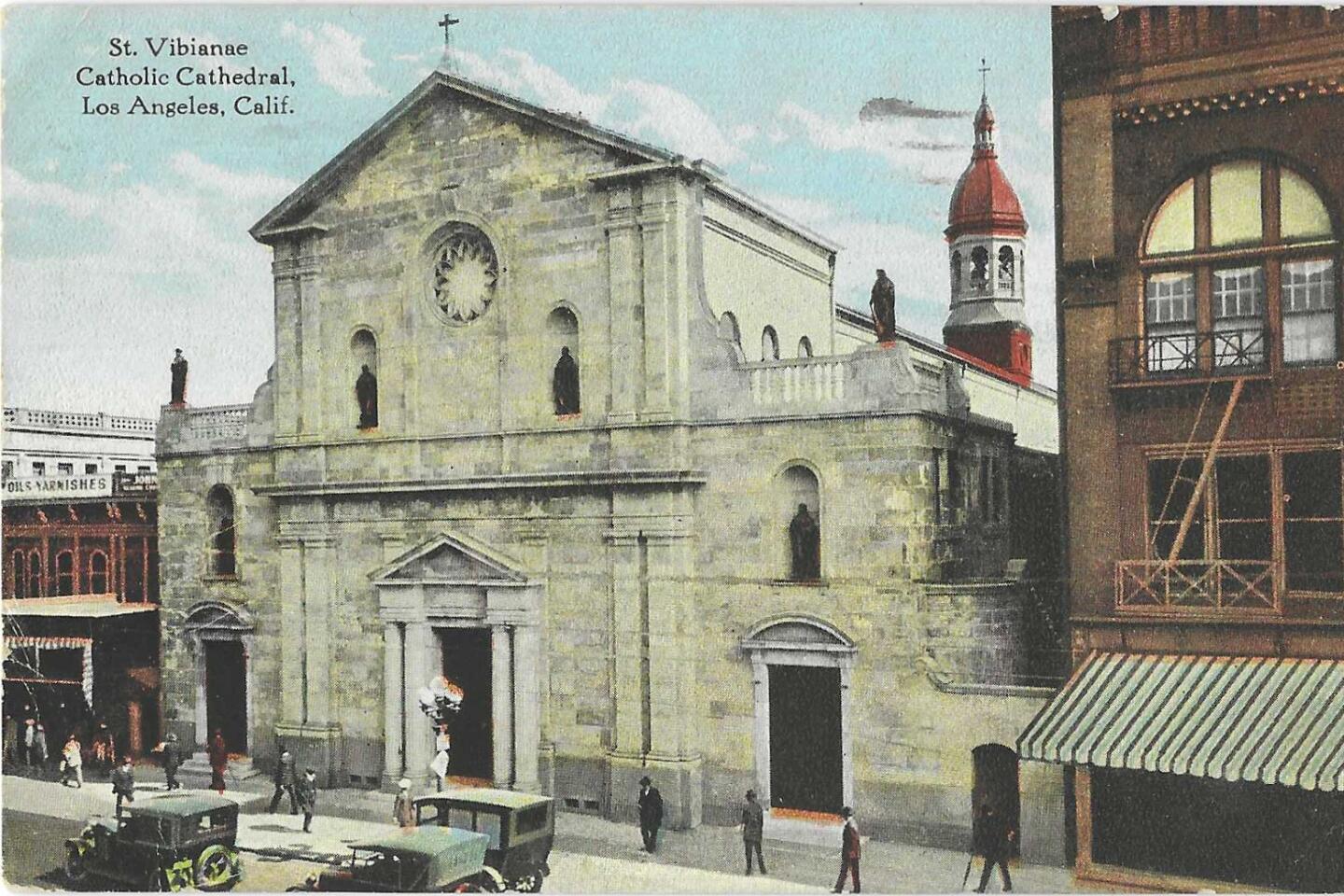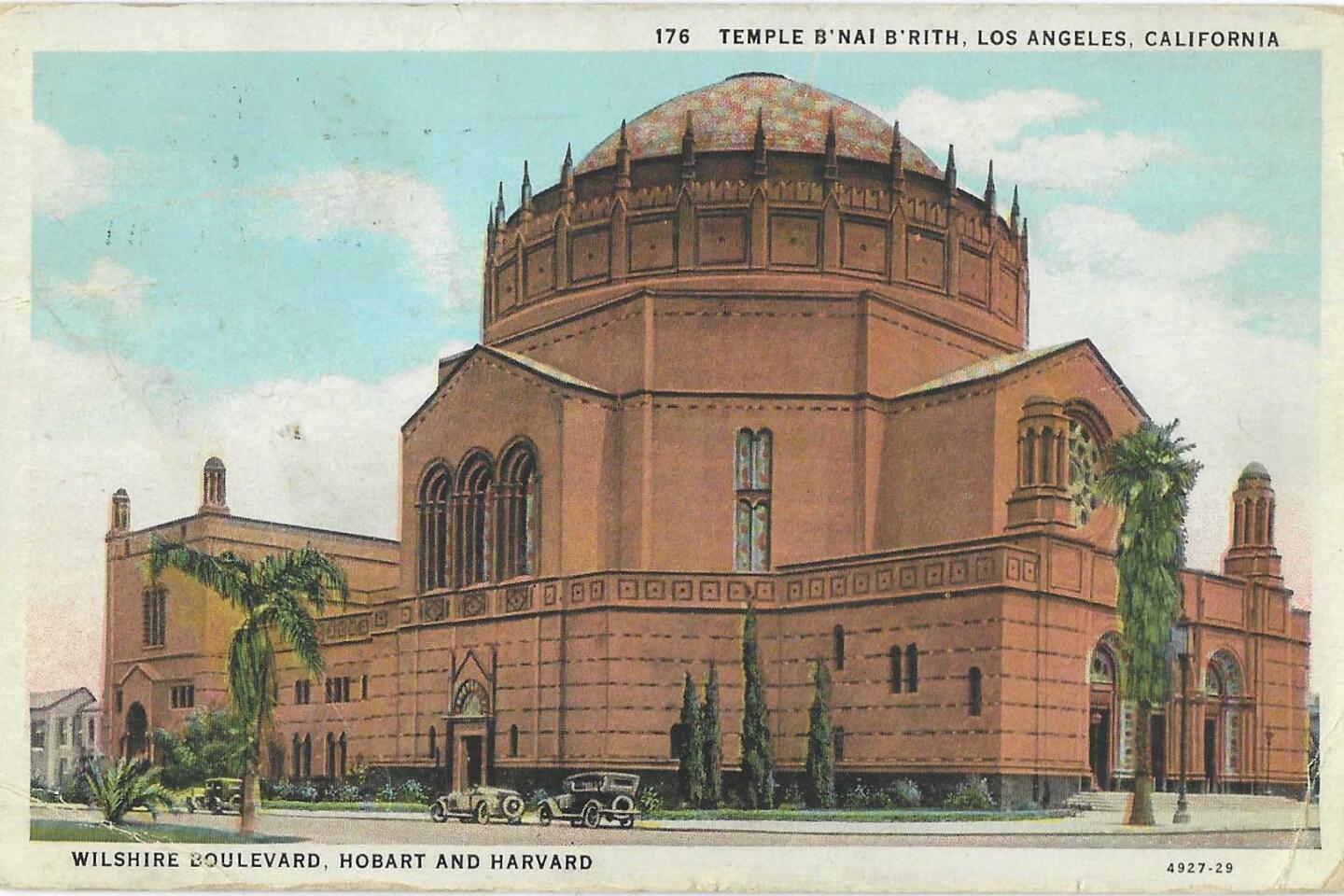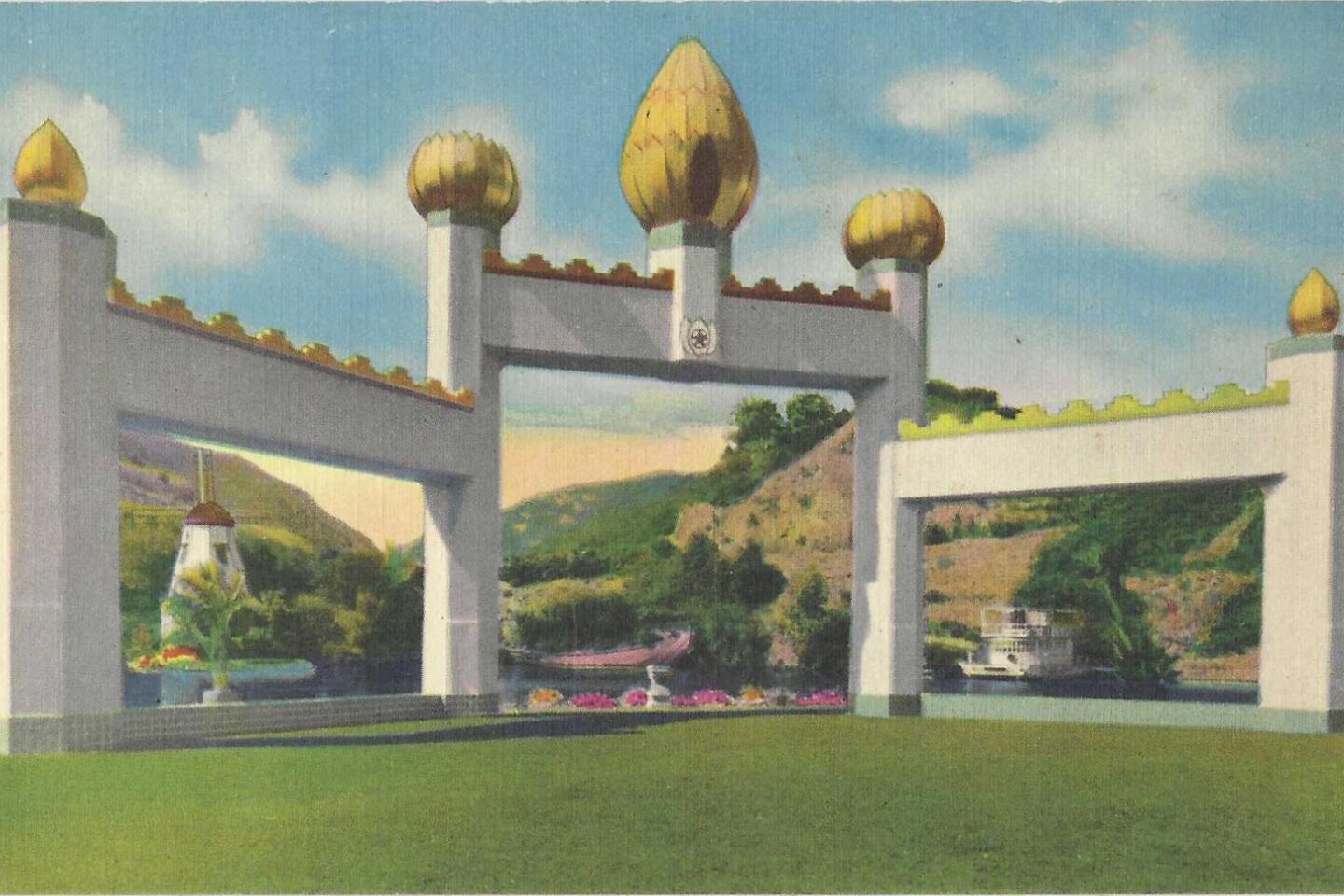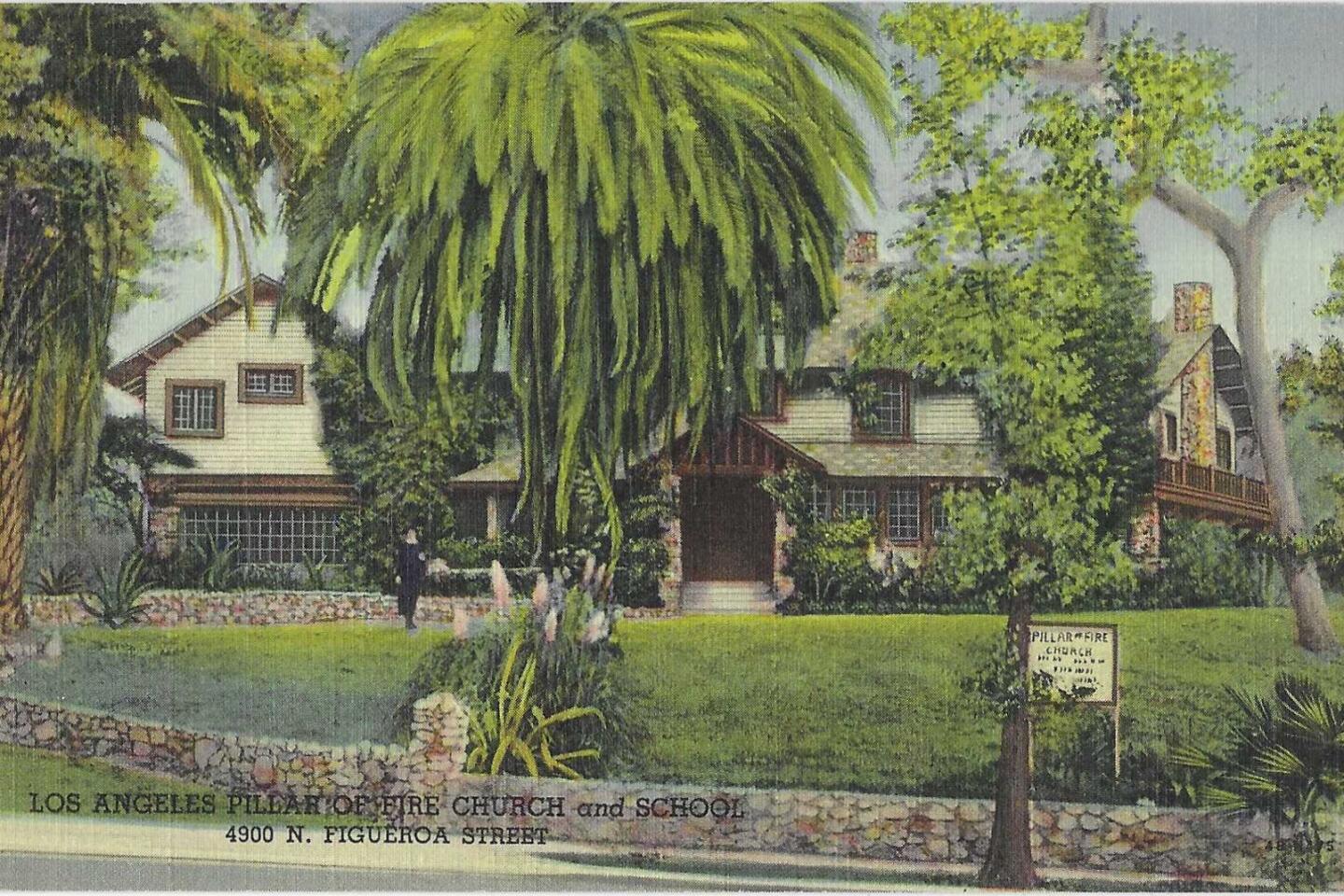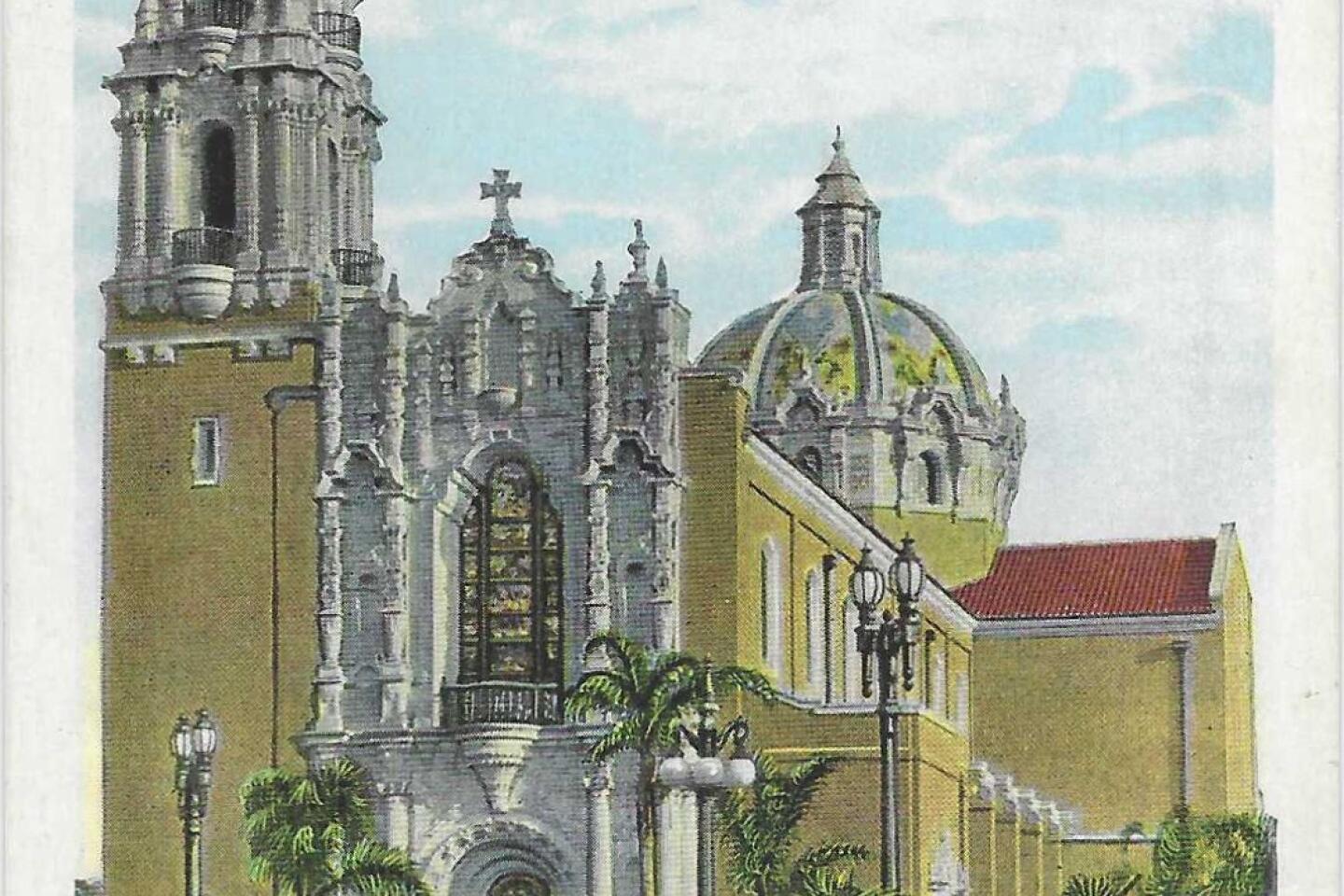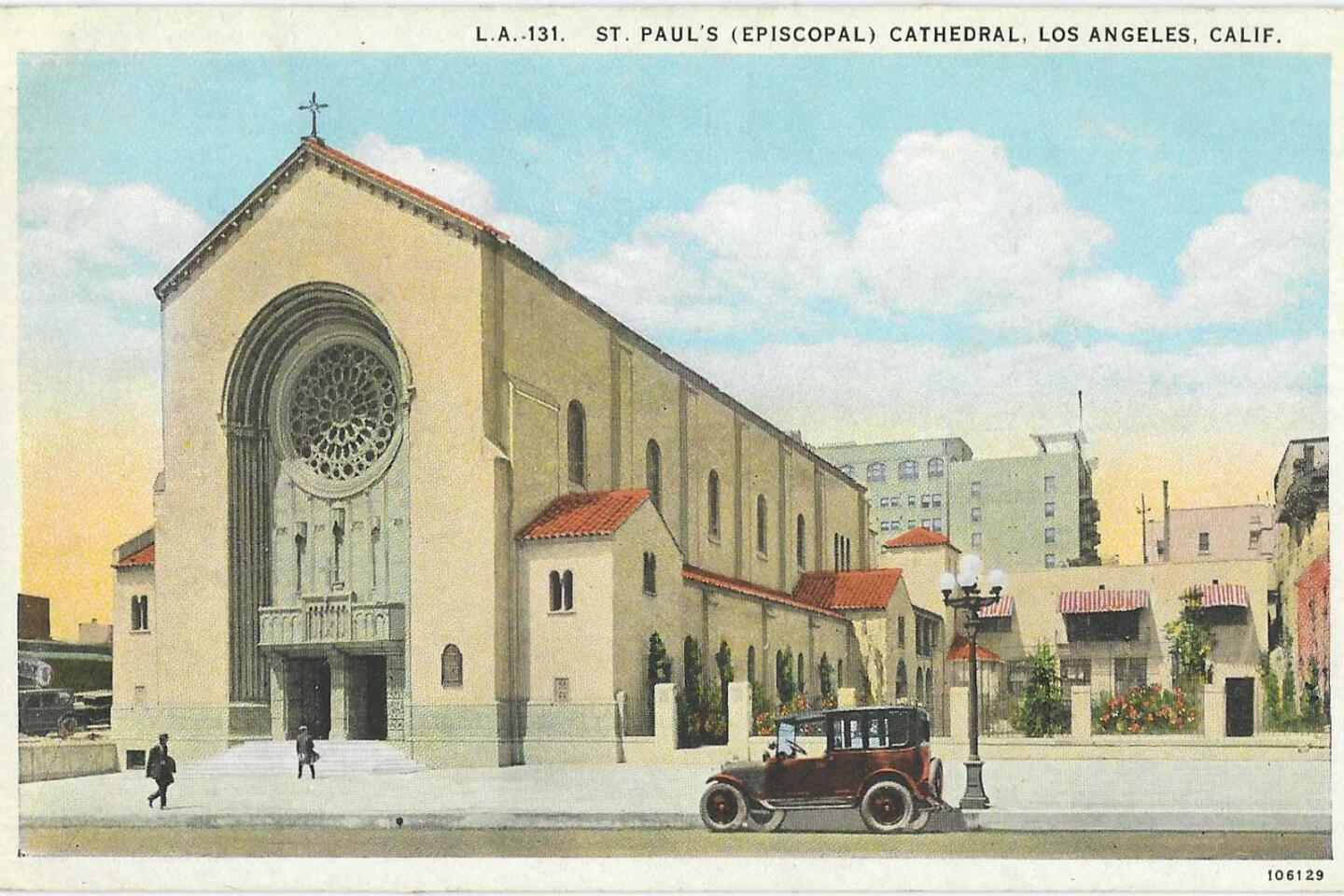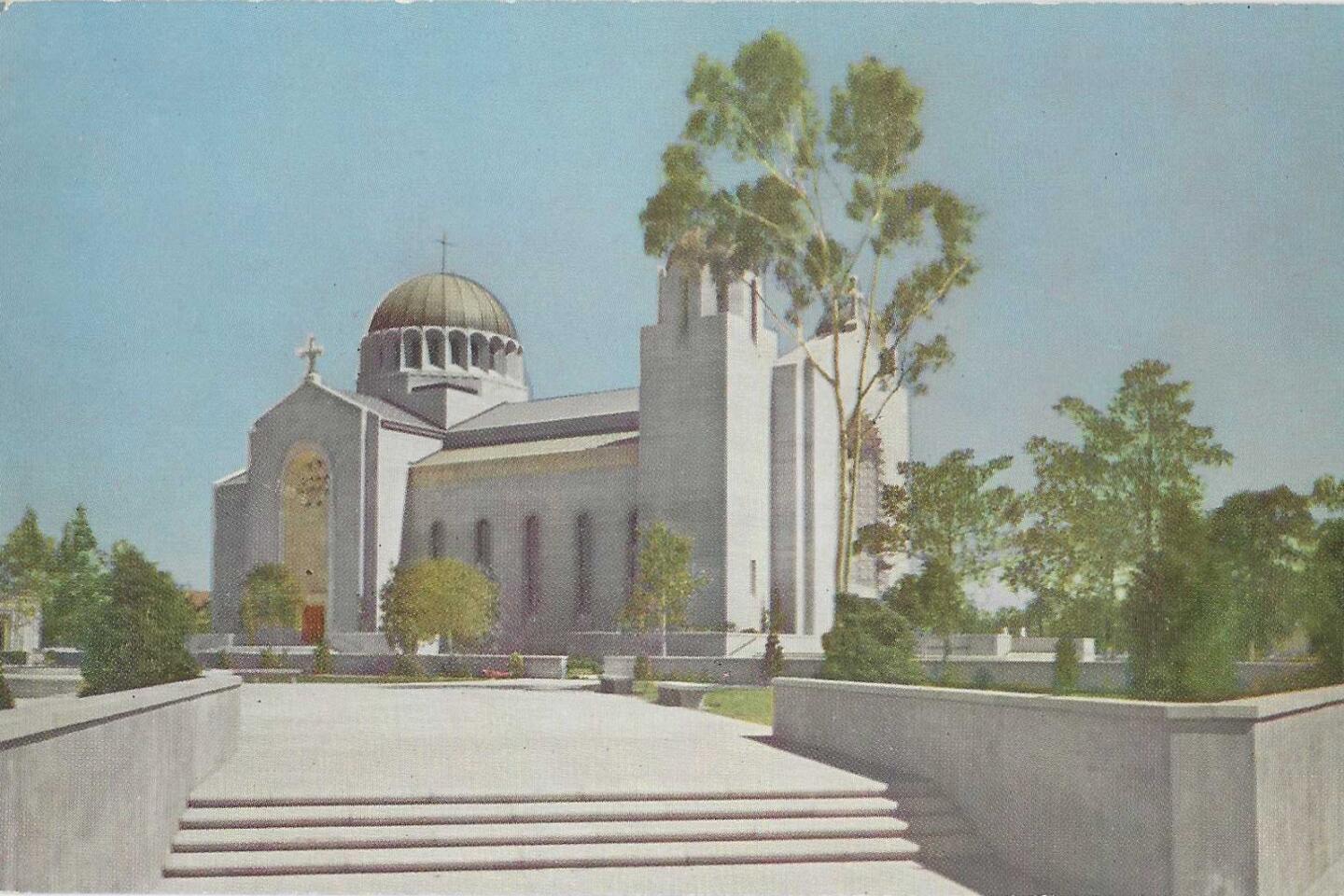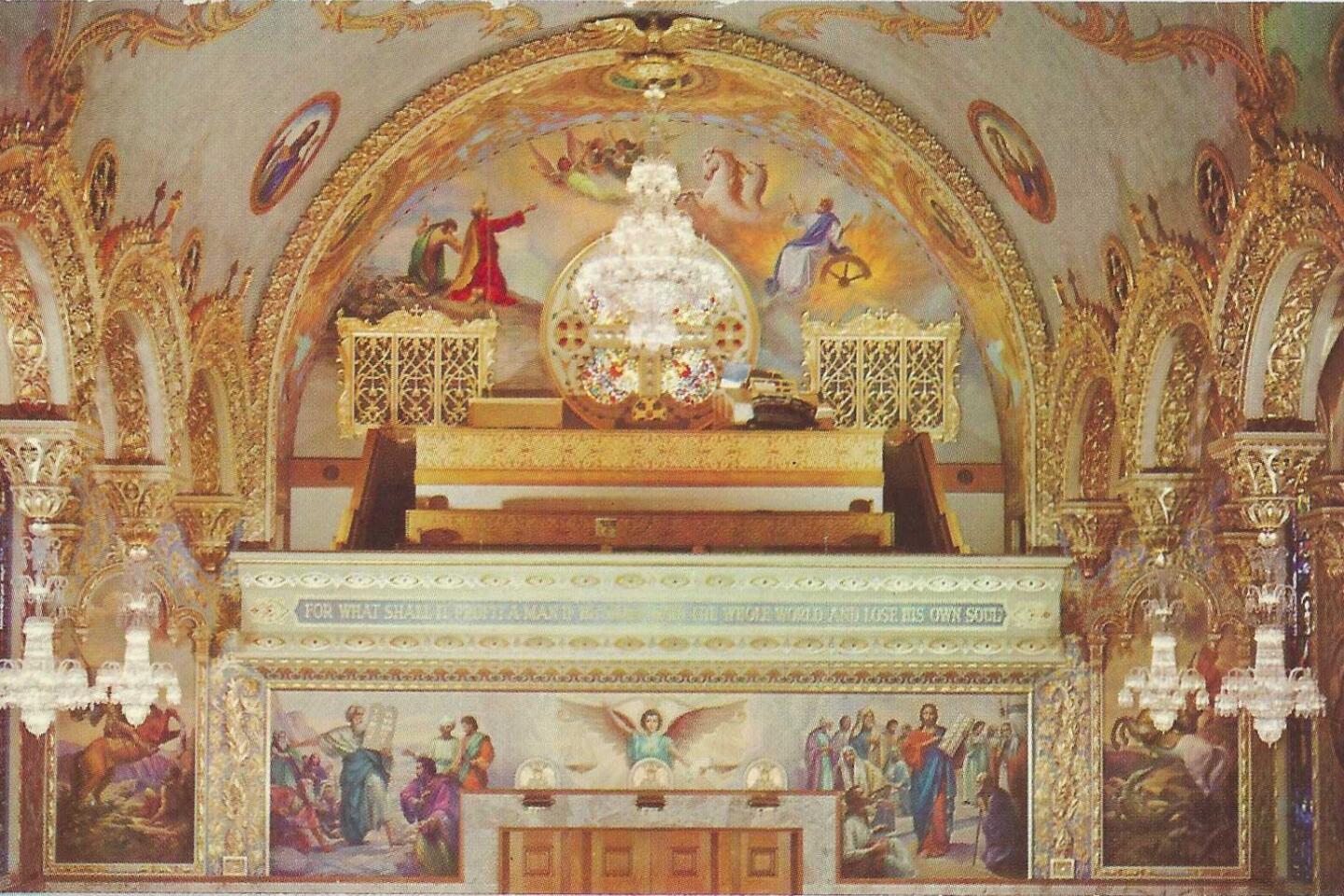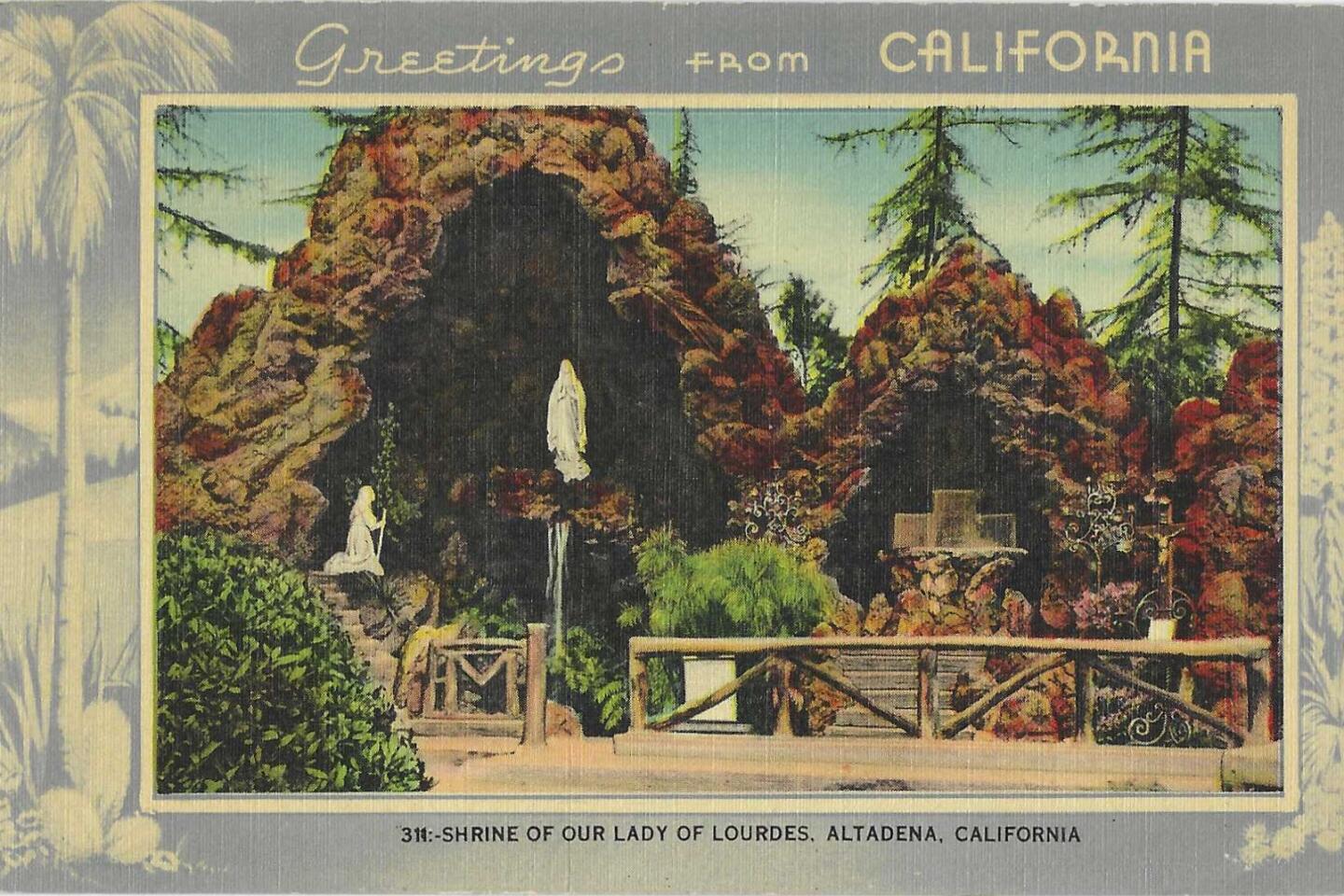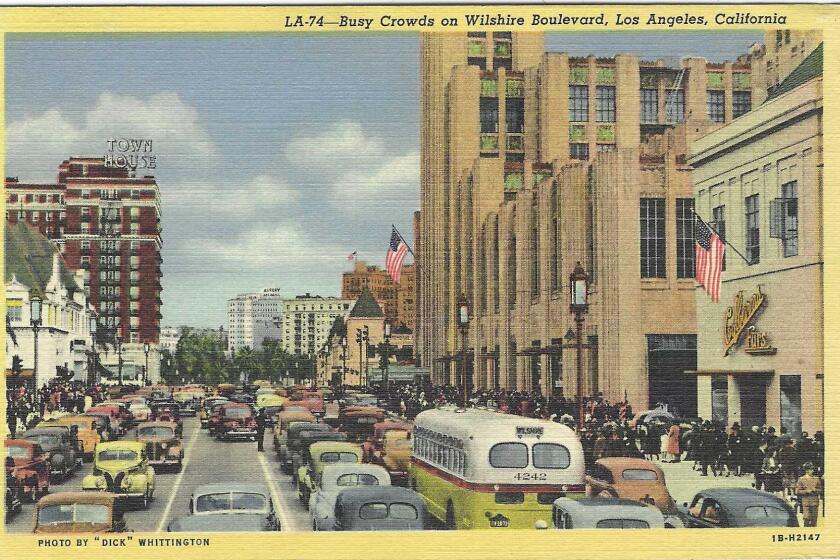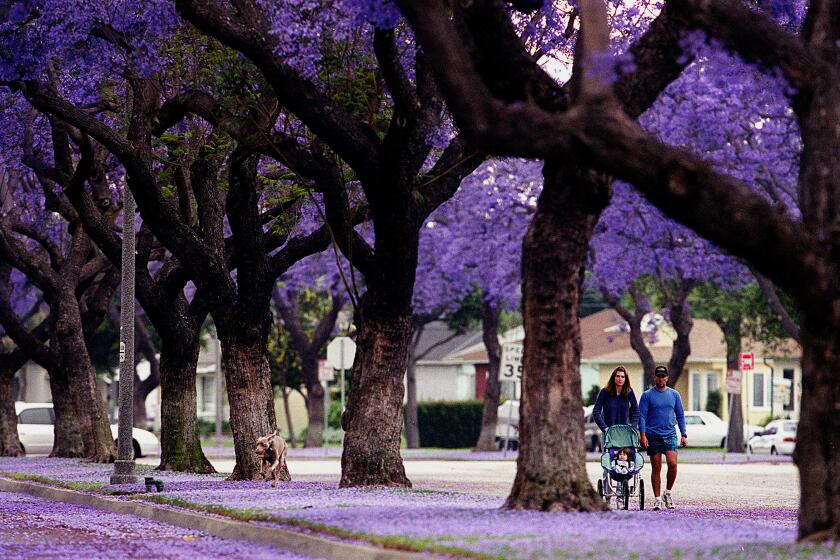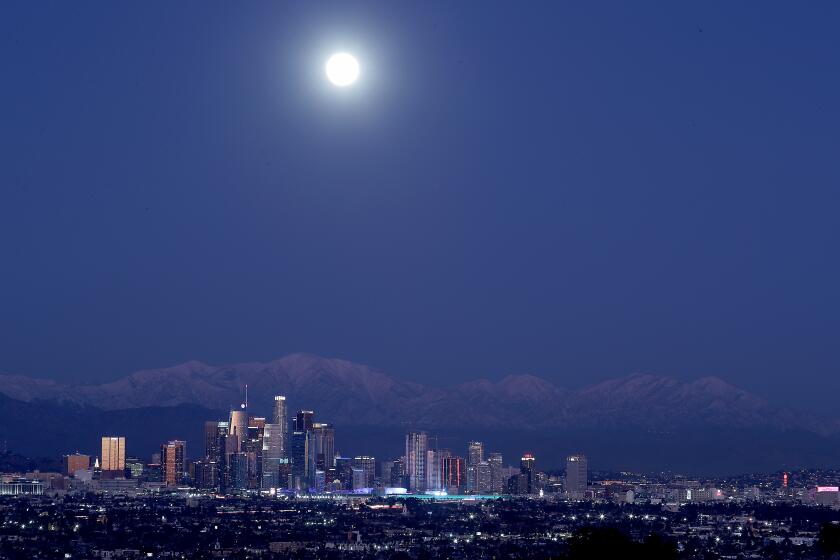L.A.’s church architecture goes way beyond your school mission project
First off, we‚Äôll have to define ‚Äúchurch‚ÄĚ ‚ÄĒ which is like picking a fight in a place that‚Äôs been nastily stereotyped as a welcome mat for way-out-there sects, like the 1920s mother-daughter cult calling itself the Divine Order of the Royal Arms of the Great Eleven, accused of sacrificing animals and fleecing its human flock.
The permanence of a ‚Äúchurch‚ÄĚ can‚Äôt be extended to the Hollywood Bowl for its Easter sunrise services, nor to the sports sanctum of Dodger Stadium, for the Mass conducted in 1987 by Pope John Paul II.
No, for this column, we’re talking about buildings of stone and steel and stucco, storefronts to cathedrals, the purpose-built and happenstance houses of worship. (This space is also an anecdotal sweep, not an encyclopedic study.)
A reader asked about church architecture in Los Angeles ‚ÄĒ a good question, because the turn-of-the-century Chamber of Commerce fantasies created around the ‚Äúmission culture,‚ÄĚ along with the blazing-bold architecture of private houses and secular public buildings, have somewhat eclipsed the far-flung architecture of neighborhood houses of worship, which could be almost as blazing and daring.
Middle-class and Midwestern immigrants brought their faiths and their tastes with them, and in consequence, some L.A. churches are line-for-line copies of ‚Äúback home‚ÄĚ sanctuaries of New England or England itself; look for them at the several Forest Lawns. Some denominations‚Äô ‚Äúhome offices‚ÄĚ exercised veto power over church designs for a California landscape they‚Äôd never seen. Still, once in a while, you could spot a startling hybrid: white steeples with red tile roofs ‚ÄĒ Vermont mates with Ventura.
Then, in the construction rush of spectacular public buildings in the 1920s, and in the suburban building boom after World War II, churches finally got some design innovation, too.
Explaining L.A. With Patt Morrison
Los Angeles is a complex place. In this weekly feature, Patt Morrison is explaining how it works, its history and its culture.
In 1952, The Times‚Äô religion writer wrote that architecture here ‚Äúis less inhibited, not bound so closely by a tradition which, however satisfactory to past generations, is thought to many to have outlived its usefulness.‚ÄĚ
Sometimes, but not all the time. Surveying some new churches then being built in the Valley ‚ÄĒ with features we now call Midcentury Modern, such as asymmetrical designs, walls of glass and palo verde stone ‚ÄĒ a minister of an Encino Presbyterian church huffed in July 1956 that ‚Äúa church should look like a church ‚Ķ extremely radical designs are not pleasing.‚ÄĚ
Any of these would have been incomprehensible to the first Angelenos, the Tongva. The sacred structure in each village was styled like the willow huts that served as houses, and the Tongva holy place was Puvungna, where Cal State Long Beach stands, the birthplace of the prophet or deity Chinigchinich.
Work on L.A.’s original permanent church lasted little longer than a seasonal Tongvan hut. In 1815, construction to replace a building that had served the new pueblo’s faith for 30 years came to a wet, dead stop when a flood came ominously close.
A new building was begun in 1818 ‚ÄĒ sensibly, on higher ground ‚ÄĒ and dedicated in 1822, and through bad-luck weather and construction crises, Our Lady Queen of Angels, nicknamed La Placita, the little plaza, still stands across from Olvera Street. And no one can lay claim to being an Angeleno without having visited it.
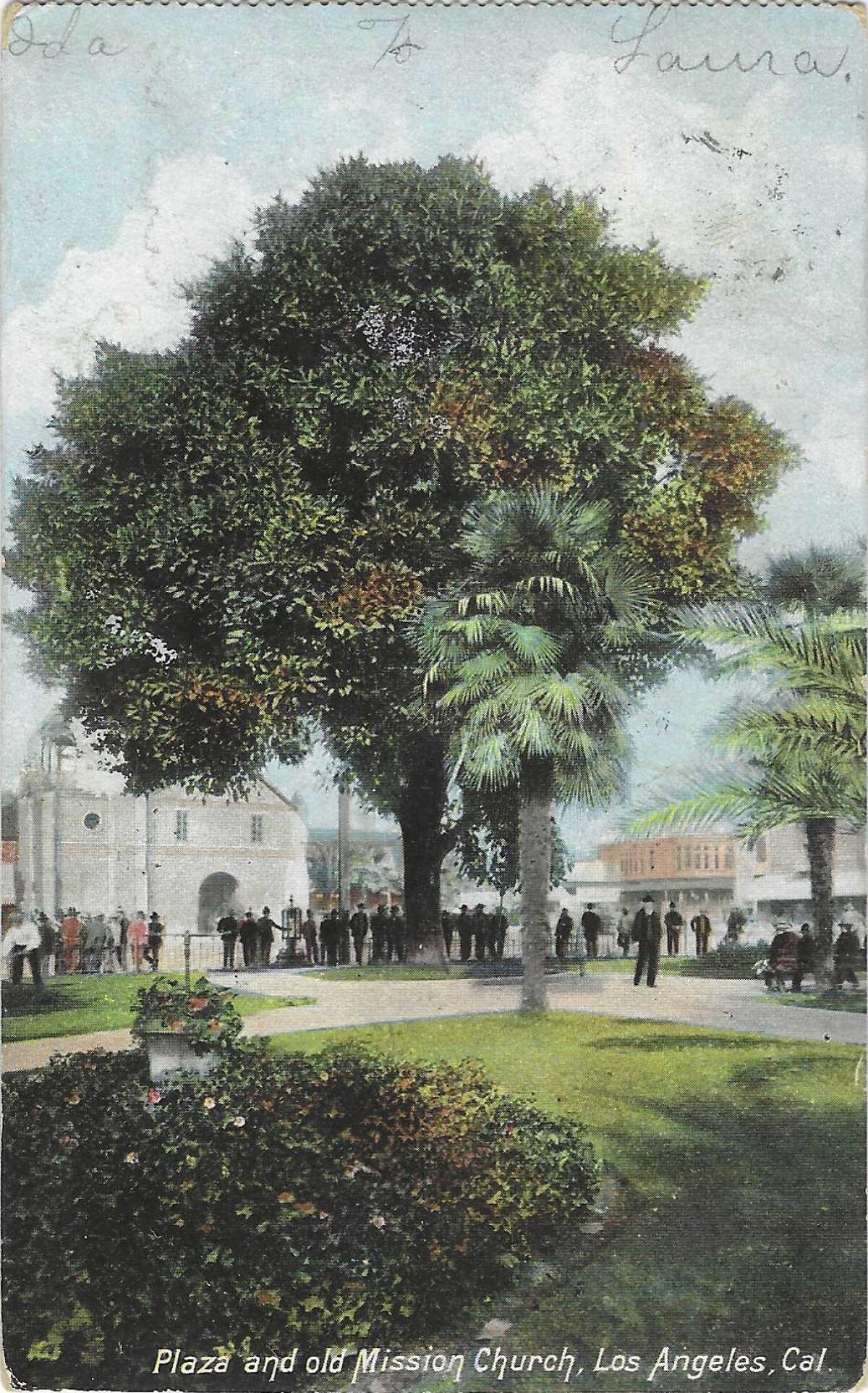
La Placita is where, in the 1980s, a bold, politically adroit pastor named Luis Olivares reinvented the church’s renown, as the nucleus of the sanctuary movement, giving shelter and protection to immigrants and refugees from Central America and Mexico.
As for early Protestants in Catholic-cradled L.A., those first worshipers organized right after the Civil War and in 1932 dedicated the impressive First Congregational Church in the Wilshire district, designed by the architects who created Royce Hall at UCLA.
At the intersection of Adams Boulevard and Figueroa Street, you‚Äôll see L.A.‚Äôs sacred and profane self. On one corner, the ornate landmark church of St. Vincent de Paul, nearly 100 years old. On the far kitty-corner is St. John‚Äôs Episcopal Cathedral, with its dour Romanesque exterior. And next to St. John‚Äôs and across Figueroa are monuments to L.A.‚Äôs secular ‚Äúsmall-r‚ÄĚ religion: a gas station and the 1923 Southern California Automobile Club.
L.A.‚Äôs 1850 census recorded eight Jewish residents ‚ÄĒ all single men ‚ÄĒ and very soon, a Jewish benevolent society organized and established a cemetery in Chavez Ravine. Holy day gatherings at first moved from one house to another, even into the city courthouse, until a proper place ‚ÄĒ the B‚Äônai B‚Äôrith Synagogue ‚ÄĒ was built in 1873 on Broadway between 2nd and 3rd streets. It was knocked down in 1896 when the congregation moved into grander quarters at 9th and Hope. About 90 years later, as The Times was building a parking garage on the Broadway site, crews unearthed two red sandstone blocks incised with stars of David ‚ÄĒ likely the capstones of two pillars of the city‚Äôs first synagogue.
In 1929, the grand, domed Wilshire Boulevard Temple ‚ÄĒ still a landmark on L.A.‚Äôs great east-west corridor ‚ÄĒ was dedicated, and many of its adornments were the gifts of Hollywood‚Äôs Jewish moguls: the Warner brothers, Irving Thalberg, Carl Laemmle and Louis B. Mayer.
The completely magnificent St. Sophia Greek Orthodox Cathedral also has a Hollywood story: The immigrant Skouras brothers, Charles, Spyros and George, had lost their theater-company fortune in the Depression. Charles pledged to God that if they made it big in Hollywood, he would build a cathedral the likes of which had not been seen before.
He did make it, as head of Fox West Coast, and the cathedral near Pico and Normandie is the multimillion-dollar proof. It was built in 1952, a long, long way ‚ÄĒ in every sense ‚ÄĒ from the warehouse north of downtown where L.A.‚Äôs Greeks held their first church services around 1906.
It wasn‚Äôt long after that, and not far away, that Buddhist temples were first built near Little Tokyo and in both the original and the remade Chinatown. A hundred years later, there are enough of them that Yelp can offer a guide to the ‚Äúbest 10 Buddhist temples in Los Angeles.‚ÄĚ The Japanese American National Museum in Little Tokyo is partly housed in the 1925 Nishi Hongwanji Buddhist Temple; during World War II, the temple served as a storage place for the possessions of some Japanese and Japanese Americans sent to internment camps.
Purpose-built places of worship can be found in almost any neighborhood, but so can repurposed buildings now devoted to the divine but never built with that intention. This is completely in character for L.A., the reinvention destination.
Linda Dishman heads the Los Angeles Conservancy. For more than 40 years, her group has campaigned to keep remarkable places from L.A.’s earlier self on its present-day landscape.
When Dishman was growing up in Sacramento, her family went to a church in a converted bowling alley, so ‚ÄúI think you can have religious activity and not be in a piece of religious architecture,‚ÄĚ she said.
Over the decades in L.A., churches can stay put, but the congregations change. That happened at the Episcopal Church of the Epiphany in Lincoln Heights. It dates to about 1887, designed by an English church architect and expanded by the L.A. architect who designed Riverside‚Äôs Mission Inn. ‚ÄúTwo great architects in one building,‚ÄĚ Dishman said.
As the worshipers became principally Latino, the church ‚Äúwas in the very center of the Chicano civil rights movement. [The newspaper] La Raza was printed in the basement. Walkouts were planned in the church. Moratorium marches were organized there,‚ÄĚ Dishman said. ‚ÄúI think that makes the church so fascinating.‚ÄĚ
(This bit has nothing to do with the architecture but everything to do with L.A.: The church’s current pastor is a former actor, the son and grandson of actors and was once front man for a punk rock band. Can the archbishop of Canterbury match that?)
Angelenos can be spotted a mile away in other locales, waiting for the walk sign while locals jaywalk with abandon. What’s that about? And what happens when people do jaywalk here?
Like Dishman‚Äôs bowling alley as church, storefront places of worship across L.A.‚Äôs great plain were once houses, neighborhood markets, beauty salons, auto repair shops. Now they‚Äôre faith centers and refuges that open their doors smack in the middle of neighborhood problems spiritual and temporal ‚ÄĒ poverty, drugs, broken families ‚ÄĒ serving as makeshift food banks, wardrobe giveaways, spots for coffee and sympathy.
In a city that bulldozes its heritage pretty breezily, grand buildings can stick around by flipping identities.
A monumental Methodist church on Pershing Square in downtown L.A. was knocked down and the land sold to showman Sid Grauman for $1 million for his Metropolitan movie theater; years later, in a karmic switcheroo, Grauman’s Million Dollar Theater a few blocks away became for a time a Spanish-language religious tabernacle.
The old Cedars of Lebanon Hospital in East Hollywood, now painted Aegean blue, is the Church of Scientology’s Pacific Area Command Base.
Our original Roman Catholic cathedral, St. Vibiana’s, built in 1876 in downtown L.A., was the center of a 1996 demolition drama. The Catholic church wanted Vibiana’s taken down after the 1994 Northridge quake and was already whacking away at the cupola (evidently without a demolition permit) when the L.A. Conservancy got wind of it and stopped the wrecking crew.
Eventually, the archdiocese agreed to a land swap and built its new cathedral uptown and uphill, designed by Spanish architect Rafael Moneo. Vibiana‚Äôs ‚ÄĒ no ‚Äúsaint,‚ÄĚ deconsecrated and sans stained glass ‚ÄĒ is now a happening party space. (I went to an after-party there for a season premiere of ‚ÄúThe Walking Dead,‚ÄĚ and the hired zombies lolling and strolling around the old altar space were admittedly freaky for anyone like me, who remembered the place in its churchly incarnation.)
A Spanish-language Seventh-day Adventist church on South Alvarado Street at Hoover Street started out in 1912 as a Christian Science church, designed by Elmer Grey, who created the Beverly Hills Hotel and the Pasadena Playhouse. After the building was sold in 1972, it was briefly a branch of the Peoples Temple, whose congregation followed its leader, Jim Jones, to Guyana and to mass suicide in 1978.
As you see, big-name architects like doing big church projects.
Garden Grove is a little far afield for the reach of this column, but the original drive-in space that became the Crystal Cathedral (and is now the Roman Catholic Christ Cathedral) was designed by Los Angeles’ Richard Neutra, and Philip Johnson did the cathedral itself.
You can determine L.A.’s seasons by our plant life. For example, right now, it’s jacaranda-blooms-stuck-to-your-windshield season. And to understand the Southern California landscape you see, you have to realize that, like you, it is probably not from around here.
Enlisting avant-garde architects was pretty radical for the time. The church‚Äôs founder, Robert Schuller, told The Times 40 years ago that ‚Äúthere‚Äôs a place for monuments. If the monument can be an instrument, you‚Äôve got a winner.‚ÄĚ
Neutra‚Äôs design inspired L.A. County‚Äôs first drive-in church, the Valley Community Drive-In Church, built in 1967 in San Dimas, with room for 900 humans inside and 400 cars outside. Its builder was delighted with it: ‚ÄúHere they are building a Protestant church with a Jewish architect and a Catholic contractor. That‚Äôs about as ecumenical as you can get.‚ÄĚ The architect, Benno Fischer, was a partner of Neutra‚Äôs and a survivor of Nazi death camps.
A. Quincy Jones and Frederick Emmons came up with the classic Valley Midcentury Modern house of worship, the striking St. Michael’s and All Angels Episcopal Church in Studio City, its A-frame shape seeming built of wood and light.
For about a century, celebrities have loved and lived in houses designed by Wallace Neff, a celebrity among architects for pioneering the Southern California residential style. Neff’s only church design was a gift to his parish. St. Elizabeth of Hungary is still a Roman Catholic church in Altadena, with a model of the grotto at Lourdes.
The striking, domed Founder‚Äôs Church of Religious Science west of downtown L.A. is the handiwork of the renowned Black architect Paul Williams, who also donated his designs for the celebrated First African Methodist Episcopal Church ‚ÄĒ FAME ‚ÄĒ in the Jefferson Park neighborhood.
Williams designed the expansion of the church’s earlier site in downtown L.A., where the Rev. Martin Luther King Jr. would come to preach. That complex burned down in 1972, a year after it was declared the first Black historical-cultural landmark in L.A.
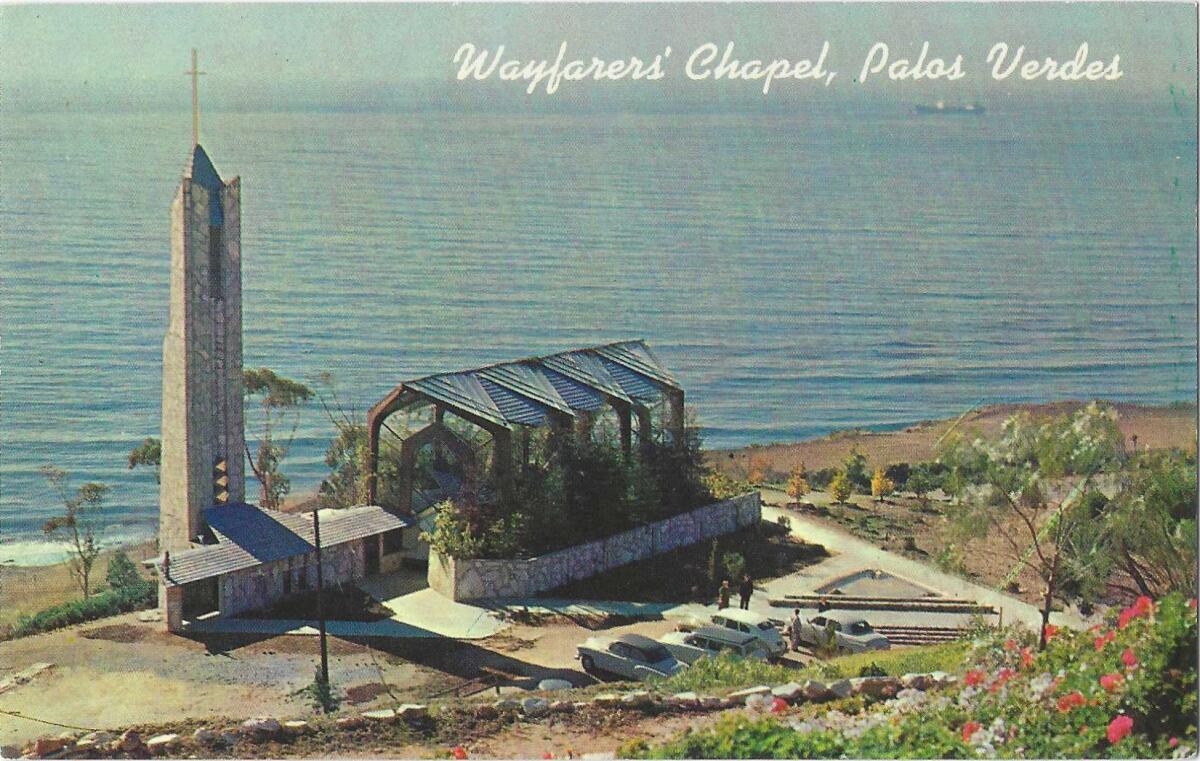
A most famous name is credited with perhaps the most spectacular ‚ÄĒ and spectacularly situated ‚ÄĒ of Southern California‚Äôs churches. On Portuguese Bend on the Palos Verdes Peninsula, the Swedenborgian Wayfarers Chapel, designed by Frank Lloyd Wright‚Äôs son Lloyd Wright, opened in 1951. It looked like it was barely there, an angular box of glass set above the sea in a frame of redwoods. Even with the long and winding road from L.A., it may be the most selfie-worthy place of worship around.
Any innovation to church architecture got some attention, and usually some criticism. I was charmed by the April 1977 headline ‚ÄúParishioners Offered Living Room Comfort,‚ÄĚ about Glendale‚Äôs new United Community Church and its ‚Äúsofa-type seating for 1,450‚ÄĚ ‚ÄĒ instead of rigid wooden pews, a setup that let parishioners look down on the minister, instead of the other way around.
The year before, an unorthodox design for a Presbyterian church in Pasadena sent hundreds of members stomping out of the congregation and hundreds of others tearing up their donation checks. Looking at the church now, it’s hard to understand why the 120-foot bell tower, curved and angled walls and massive freeform stained-glass window were so radically offensive ... distractingly original, maybe, but surely not offensive.
In 1994, a Hindu temple planned for a 1950s neighborhood in Norwalk finally got approved, after the footprint was downsized and golden domes were scrapped for a Spanish-style red tile roof. Two years later, the Islamic Center of Northridge had to give up on plans for a mosque near Cal State Northridge. The center‚Äôs director, Ahmed el-Gabalawy, told The Times that ‚Äúwe showed a neighborhood meeting a drawing of a minaret and dome, and they came unglued. They voted heavily against it.‚ÄĚ
By sheer headline count, the contender for most famous church building in Los Angeles is the Angelus Temple, the singular 98-year-old Foursquare Church in Echo Park. It opened its enormous domed space to thousands of worshipers on New Year’s Day 1923, the roof brightened by crushed abalone shells mixed with the paint, and the sanctuary brightened for many years by the sheer showmanship of its founding pastor, the Canadian-born Aimee Semple McPherson.
A fictionalized version of ‚ÄúSister Aimee‚ÄĚ appears in HBO‚Äôs ‚ÄúPerry Mason‚ÄĚ series, and a fictionalized Angelus Temple is played by the Christian Science Church in West Adams.
And can we overlook other churches in the movies? We cannot, because the movies don‚Äôt overlook churches. That was Hollywood United Methodist Church you saw in ‚ÄúSister Act.‚ÄĚ In ‚ÄúEnd of Days,‚ÄĚ Satan rises up from the floor of St. Vincent‚Äôs to do battle with Arnold Schwarzenegger. And Judy Garland mourns her husband‚Äôs suicide in ‚ÄúA Star is Born‚ÄĚ at the Church of the Good Shepherd in Beverly Hills, the parish church for a congregation of stars and star-makers.
Any number of savvy churches have signed themselves up on location scouts’ websites as ready for their closeups, the internet version of sending glossy headshots. Maybe IMDb should think about creating a webpage just for credits for houses of worship.
L.A. is a place like no other. You’ve got questions. Patt Morrison probably has answers and can definitely find out.
More to Read
Sign up for Essential California
The most important California stories and recommendations in your inbox every morning.
You may occasionally receive promotional content from the Los Angeles Times.
